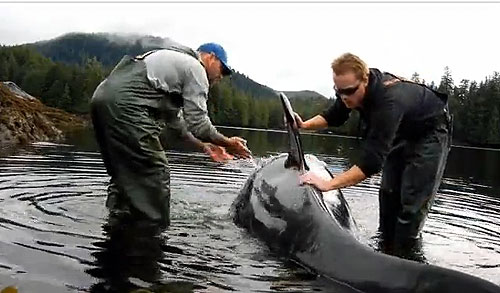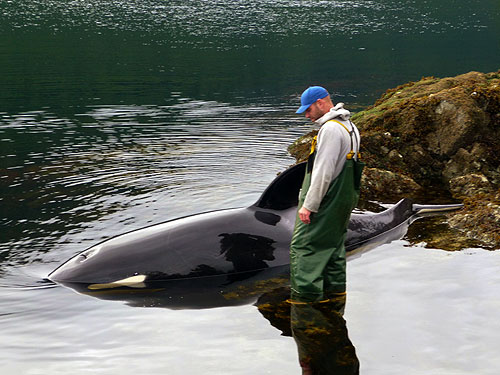
Shrimpers Rescue Young Killer WhaleBy MARY KAUFFMAN November 07, 2013
That day, aboard the Miss Mary, fellow shrimpers, Nick Segal, John Oakes (owner), and Jason Vonick, had been looking for different places to set the shrimp gear before the season started. They were just preparing to anchor in Klakas Inlet Bay on Prince of Wales Island for the day when, "Out of the corner of my eye," said Vonick, "I caught some splashing and thrashing about and when I looked over there were some Killer Whales chasing some seals." Vonick said he grabbed his camera to film the whales and then realized that one smaller whale had gone up on the rocks while chasing a seal and "got herself stuck". Before they anchored Miss Mary, the fishermen went over to take a look and saw other members of the pod attempting to assist the younger whale. Among them was a large male.
Jason Vonick and Nick Segal splashing water on a young Killer Whale grounded on the rocks at Klakas Inlet Bay on Prince of Wales Island Vonick said they stayed with the whale for about four hours splashing her with water to keep her cool. He said they worked to keep her calm and did whatever they could to keep her from getting panicky. "In the meantime, the other whales that were with her were very concerned," said Vonick. He said the other orca whales stayed very close. Vonick said, "I don't think they saw us as a threat, but you never could tell." He said, "That was a little bit nerve-racking not knowing if they were going to try to protect her or not." He said that was the only scary part of the whole ordeal, just not knowing how the other whales were going to react. "After awhile, we realized they were just going to keep their distance and they didn't do anything threatening or harming." After several hours the tide started to come back in, which was good, however, when it got to the point that the whale's blow-hole was going underwater and she could no longer hold her head up high, they knew they had to do something Vonick said. "She needed a lot more water to come in with the tide to float her off. We didn't know what was going to happen because she still needed another hour or two of water to come in." Concerned because the whale couldn't hold her head up out of the water, Vonick said he and Segal put the oars from the skiff under whale's chin and held her head up for her. "We thought, we're not going to be able to do this for long," said Vonick. When the whale took a breath and started coughing up water, Vonick said they immediately decided to stick the oars up under her pectoral fins and see if they could just push her or move her. They realized they had to do something. "We realized when we tried, we moved her a little bit," he said.
Jason Vonick and the beached Killer Whale
Vonick said the orca whale was a little scratched up from the rocks, but nothing major. He said of the whale, "It definitely had an understanding of what was going on the entire time." In comforting the whale, Vonick and Segal would pet her. Vonick said if they stopped, the whale would make a little cry and would stop crying as soon as they would begin petting her again. He said, "It was an acknowledgement that she knew we were there." Although they had their hands under her chin, by her mouth and eyes, "Never, not one time, did she ever try to hurt us at all," Vonick said. Vonick has several videos of the rescue on YouTube. He said he found one comment interesting in which a person said he would bet this whale will remember these rescuers for the rest of its life. "I completely believe that," said Vonick and, "I'll remember this whale for the rest of my life." The rescue has gained national attention appearing on FoxNews, Good Morning America, Discovery Channel, ABC, as well as numerous other media outlets. "A lot of people have been asking to use the video," said Vonick. He said YouTube informed him he could earn money from his video. At first he wasn't interested, but then decided he could donate the money back to the University of Alaska for Jan Straley's research program in Sitka. Vonick said he took YouTube up on the offer and he is going to donate any revenue generated from people watching the video to Straley's research department. Vonick explained that it doesn't cost the viewers anything to look at the video, YouTube generates the funds through paid advertising. Vonick said the whale was later identified by a research group in Canada as T068C1, a female and 6 years old. (http://www.dfo-mpo.gc.ca/Library/346784p3.pdf) It was an amazing adventure said Vonick.
Watch Jason Vonick's YouTube Videos
E-mail your news &
photos to editor@sitnews.us
|
||

